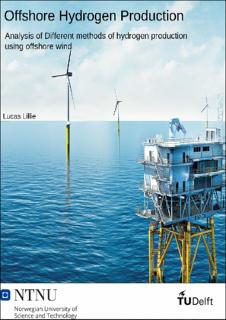| dc.description.abstract | With an increasing shift to renewable energies, solutions are required to overcome that variability and unpredictability of power production that comes with it. Hydrogen is one solution that can overcome this issue since it can be produced using renewable energy through electrolysis, it can be transported to shore efficiently by pipelines and it can be stored, like natural gas. Not only can hydrogen be used as a way to store energy, but it can also be used directly as a basis for steel production and for long-distance transport. Using wind energy, specifically offshore wind farms, as the source for hydrogen is an idea that is gaining attention. Currently, wind turbines are electrically connected, bringing their electricity to shore by high-voltage cables, allowing hydrogen to be produced onshore. Hydrogen could however also be produced at a central location in the offshore wind farm or at each individual offshore wind turbine, removing the need for high-voltage cables. The purpose of this research is to explore different methods of hydrogen production and validate a model that can simulate each method. The goal is to be able to compare the different methods and quantify the losses of producing hydrogen offshore as opposed to onshore. A time-based simulation model has been developed to represent an offshore wind farm, which would either produce electricity or hydrogen, which eventually arrives onshore. High-resolution wind data are used to correctly include short-term fluctuations in wind output. The N.O. Jensen wake model is implemented to capture the wake effects. Since wake is typically modelled steady-state, specific attention has been given to include the moving of the wake through the wind park. The power outputs for each turbine in the model could be accurately determined based on the incoming wind data. It is found that the spatial effect reduces wind power variations at the wind farm level to about 22\% of first turbine in the sting, as expected. The output of the simulation model compares the power losses of producing hydrogen through four scenarios. This model uses a total of eleven wind turbine strings of seven 10 MW wind turbines each. The power output calculated would then be used to determine the amount of hydrogen produced. By applying electrical power loss equations and calculating the pressure drops for hydrogen traveling in a pipeline by assuming steady-state and isothermal, the losses are calculated for each scenario. A sensitivity study is performed to see the effects of changing model parameters on each of the different scenarios. The model developed in this thesis allows for comparison of electricity production and hydrogen production by offshore wind turbines. It is found that producing hydrogen at the wind farm level and then transporting hydrogen to the shore (Scenario 2) has lower overall energy losses (kg of hydrogen available on shore) than using electrical cables. The same goes for individual offshore hydrogen production (Scenario 3). A high-level exploration of the economics indicates that both scenarios 2 and 3 are more economically feasible when only looking at transportation costs. It is recommended that further research is done to be able to determine which method of hydrogen production would be the most effective by taking the transportation losses and economics into account. | |
